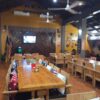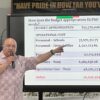Those were priceless moments indeed.
But recordings were all this reporter had of that special tour of Tinian in 2008 with more than 500 photographs save for a few lost into oblivion.
This reporter, Hap, and Jerry found themselves engaged listening intently to Don’s account of the invasion and the Manhattan Project — a riveting experience.
He talked about the work that the Seabees senior commanders began planning the development of Tinian shortly after the first aerial photograph missions were conducted in February of 1944.
Don narrates that the invasion of the Marianas was supposed to take place in November 1944 but Admiral Nimitz pushed the invasion up to June 15 that consequently gave the construction team barely three-and-a-half months to prepare for Tinian’s development with Capt. Paul J. Halloran, USN, CEW (no relation to Hap) at the helm.
He tells of how Captain Halloran found an uncanny resemblance between Manhattan and Tinian the moment he looked at the latter’s map. A native of Manhattan Island, Captain Halloran named the major street Broadway and all other streets after those streets familiar to him in New York.
And the massive construction that would transform Tinian into the world’s largest operational airbase began.
As the tour proceeded to the bomb pits, Hap Halloran raised a good question: “Which one is Pit No. 1 and Pit No. 2?”
Don says he and other historians agree that both “Fat Man” and “Little Boy” were loaded in one pit.
“There was no bomb pit No. 1 or 2. It was created in the minds of the people when they put up the original monuments,” he says.
Hap also recalls a conversation he had with Col. Paul Tibbets who said, “I don’t know why they built the second pit because we never needed it.”
Don explains that everything in the Manhattan Project had redundancies. “Everything had a backup.”
Prior to the Enola Gay and Bockscar missions, Don says an intermediate base was built on Iwo Jima with two hardstands and one atomic bomb pit.
He says should Enola Gay or Bockscar encounter mechanical problems, a standby plane was ready to continue the mission.
It was also on Iwo Jima, Don says, where Enola Gay, The Great Artiste (the plane carrying instruments to measure the bomb’s strength) and The Big Stink (a photographic plane) met en route to Hiroshima on August 6, 1945 where “Little Boy” was dropped.
For Don, the mission was perfect — as they waited for the perfect opportunity to do it that took the Japanese by surprise.
Now it was time for the second mission with Kokura — and not Nagasaki — as initial target.
Colonel Tibbets, Don says, chose Major Charles W. Sweeney to fly the mission that shocked General LeMay who was expecting Tibbets to do it knowing how the Enola Gay operated perfectly — “same plane, same people, same job.”
Don says Sweeney had the prerogative to use his plane The Great Artiste which he used in the Hiroshima mission. Running short of time to move the instruments to another plane, Sweeney settled for Bockscar.
Don explains that despite all planes being the same, each had its quirks. He says Sweeney’s team couldn’t get the fuel transfer pump on the auxilliary fuel tanks to work resulting in the mission’s delay.
Aside from his crew’s adjusting to Bockscar — named after its commander Captain Frederick C. Bock — they had to deal with a bad weather. Rather than rendezvousing in Iwo Jima, the planes met at the south end of Kyushu, on Yakushima where none of them had ever flown over. Don says the photographic plane — The Big Stink — never made it.
From Yakushima, Bockscar and The Great Artiste flew to Kokura, the initial target.
Don says the city was covered in haze and industrial smoke, and possibly due to nearby Yawata had been bombed the day before.
“The plane made three passes at Kokura without seeing the target as required. It was as if the bomb didn’t want to be dropped,” says Don.
He tells how Sweeney and his men were fortunate to have had excellent radar coordination, and made one direct path over Nagasaki, the second target, where the “Fat Man” was dropped after the bombardier saw an identifiable landmark.
With the bomb’s release, Bockscar sped for home only to discover that the auxiliary fuel tank was broken and would obviate the use of 600 gallons of gas stored in it to complete the journey home.
Don narrates how Bockscar steered for Yontan, a newly captured base on Okinawa where an emergency landing had to be made with the gas gauge reading empty.
Bockscar dove for the runway, says Don and it lost one engine from fuel starvation.
“The plane hit the runway hard, bouncing about 25 feet in the air, then making an emergency turn at the very end of the runway. Then all other engines began coughing to death. When the plane was finally parked and they measured the tanks, seven gallons of useable fuel was all that was left,” says Don.
He says Sweeney, along with the crews of the other two strike mission aircraft that also arrived low on fuel, took on half-a-tank for the ride home and left.
As Sweeney and his crew made their way back to Tinian, Nagasaki was left in shambles.
Emperor Hirohito, Don says, made his final decision to end the war and his tentative acceptance of “unconditional surrender,” was wired from Tokyo at about 6:00 a.m. on the morning of Aug. 10.
According to a handout distributed to veterans who took part in Valor Tours’ Mariana Islands tour in 2008, as Bockscar headed back to Tinian, most of the crew members had fallen asleep on their way back for an hour and a half. “The autopilot had done a great job of keeping us straight and level, had only lost a few hundred feet,” narrates an unnamed radar operator.
Whatever happened to Sweeney when he landed on Tinian is enough fodder for another story.
But finding the recording of those conversations with Don, Jerry and Hap on Tinian in 2008 gave this reporter something to be excited about and something to think about as the world remembers what happened on Tinian that fateful week in August 1945.
This reporter imagines how Tinian was like the week before the dropping of the bomb — how frantic preparations were being made to ensure the mission’s complete success.
There was little room for mistake and they couldn’t afford to make one that would have rendered the mission botched.
From the secret delivery of the bombs’ components on July 26, 1945 by the USS Indianapolis, Tinian was ready for its major role. The largest operational airbase in the world was ready for a mission to bring peace 66 years ago.










